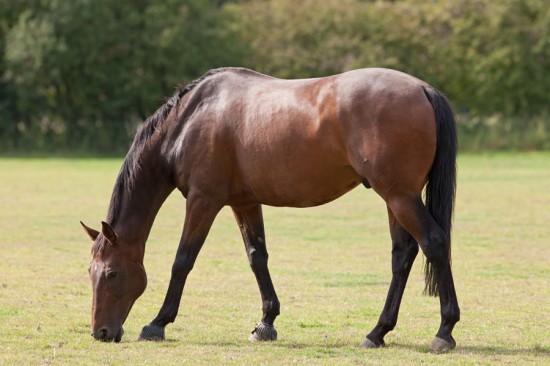
I was passing a local field the other day, in my car coming home and an extremely distraught rider came flying out of the field in floods of tears. I nearly added to them by running her over, she was so distraught. Getting out of the car in a hurry she dragged me into the field to see her horse, a stunning red, with a fracture just below the front fetlock. In fact the only thing holding the bottom of his leg on was a strip if skin, it was horrific. 'Red' must have been in acute distress, as was his owner. She was too distraught to think straight. I called the Vet but I feared the worst. The Vet arrived pretty quickly and as I suspected the news wasn't good.
I was very upset myself then. I went straight home and to my computer to write this article. There was little that could be done for poor 'Red' but I realized that many riders might not know what they could or should do for an injured horse whilst waiting for the Vet, so here's some advice.
Horses can injure themselves in fields, whilst being ridden or competing. Should your horse sustain a really bad injury 'The Center For Equine Health' gives the advice below on treating severe cuts, limb fractures or injuries where the horse is unsteady on its feet.
Severe lacerations with bleeding.
Using a clean dressing, apply pressure with your hand directly over the source of bleeding.
Gently clean the wound with a cold water hose only if it is really dirty or has stones, or anything else stuck to it.
Do not apply any medication, disinfectant or ointments to any wound that may require suturing or stitching, because these may cause tissue damage that can interfere with the suturing procedure. As a general rule, the less done to the wound before the veterinarian gets there, the better.
If the horse is likely to be transported to a veterinary clinic or if there's going to be a delay before the veterinarian arrives, apply a clean pressure bandage directly over the wound. Use plenty of padding between the injury and the bandaging material. Elastikon and or Vetwrap should be applied firmly enough to lessen bleeding but not so firmly as to cut off circulation. Always leave some of the padding material showing at the top and bottom of your wrap. Tourniquets are not recommended for use by untrained people.
Limb fractures or injuries with instability.
Stabilize the injured limb in the first few minutes after a bad bone injury. This will prevent further injury to the affected limb and its blood supply and will reduce the animal's pain.
If a proper splint is not available, you can make one with a pillow and several rolls of Elastikon tape or Vetwrap type bandages. Wrap the pillow around the leg and apply the tape pulling the pillow as tight as you can while wrapping. After several rolls of tape have been applied, the bandage will become very stiff, thereby stabilizing the leg. This is only a short-term solution which will need to be replaced with more permanent stabilization as soon as possible.
If you do feel you have to use tranquilizers in a severely injured horse, use a very low dose. These animals easily fall into shock and higher doses of tranquilizers can make low blood pressure problems worse. I personally wouldn't recommend you use one unless there is absolutely no choice, like the animal is continuing to hurt themselves.
I truly hope that you never need this information. I will never forget the site of such a beautiful horse so badly injured, but if you do I hope it helps. My last piece of advice is that you make all those you ride with aware of this information so that if the worst does happen you can help each other out.
 One stop solution for all dog bed requirements
One stop solution for all dog bed requirements
One stop solution for all dog bed requirements
One stop solution for all dog bed requirements
 Common Diseases And Ailments Of Horses And Ponies
Common Diseases A
Common Diseases And Ailments Of Horses And Ponies
Common Diseases A
 Responsible Pet Ownership - How Many Pets Constitutes Too Many?
Responsible Pet O
Responsible Pet Ownership - How Many Pets Constitutes Too Many?
Responsible Pet O
 Find Your Dogs With A Cage Free Boarding & Grooming in Ontario
Find Your Dogs With A Cage Free Boarding & Grooming in
Find Your Dogs With A Cage Free Boarding & Grooming in Ontario
Find Your Dogs With A Cage Free Boarding & Grooming in
 Scottish Terrier Hereditary Health And Longevity
Scottish Terrier
Scottish Terrier Hereditary Health And Longevity
Scottish Terrier
Copyright © 2005-2016 Pet Information All Rights Reserved
Contact us: www162date@outlook.com